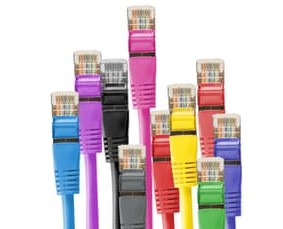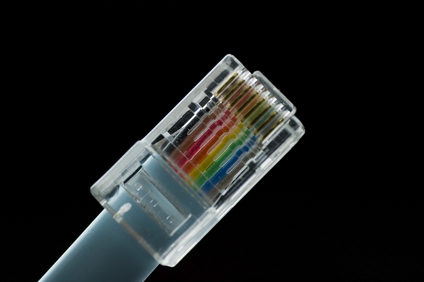
Basics and Benefits of Zone Cabling – Part 2
 As mentioned in Part 1, zone cabling designs provide benefits in materials savings, decreased installation times, and easier MACs (moves, adds, and changes). Part 2 will continue discussing the basics and benefits of zone cabling.
As mentioned in Part 1, zone cabling designs provide benefits in materials savings, decreased installation times, and easier MACs (moves, adds, and changes). Part 2 will continue discussing the basics and benefits of zone cabling.
Designs
Experts recommend CAT 5e and 6 UTP (unshielded twisted pair) zone cabling topology with a connecting block system within the ZE (zone enclosure). This configuration will render unnecessary the stocking of factory pre-terminated and tested interconnect cords for connections in the ZE, simplifying cable management through the elimination of cable slack.
Please note that CAT 6A UTP media is not recommended for zone cabling due to reasons involving performance and flexibility. UTP cabling is vulnerable to crosstalk in particular installation scenarios. In addition, it is not the best media for supporting remote power applications with loads of 30W or more. Because CAT 6A UTP zone deployment is dependent on modular connections inside the ZE, connections provided by pre-terminated and tested interconnect cords need to be available for rapidly enabling MACs. Affordable shielded zone cabling solutions are recommended to address these situations.
Cost Savings
Even though more CAPEX (capital expenditure) will be necessary for a zone cabling installation, assessing total costs should also account for OPEX (operating expenditure). The performance of MACs is classified as OPEX, and studies by Siemon found there are hundreds of dollars in savings from each move, addition, or change when using a zone cabling design versus a traditional cabling design. Their study also discovered a tipping point when ROI begins accruing from utilizing a zone cabling design.
IT (information technology) needs for many organizations evolve constantly, which requires being able to quickly reconfigure floor space. An improved capability of supporting MACs will allow owners of facilities to achieve considerable ROI benefits from deploying zone cabling systems in a two to five year period. According to Siemon, the combined costs of CAPEX and OPEX for zone cabling designs will be invariably less than traditional cabling designs
Part 3 will continue discussing the basics and benefits of zone cabling.
Progressive Office Cabling
Founded in 1986, Progressive Office’s success has been a direct result of years of commitment to seeking solutions on behalf of our clients in the Washington, D.C. and New York City areas. Efficiently working together, Progressive teams get cabling installed and operating as fast as possible while minimizing disruption and downtime. Call our toll free number (800) 614-4560 today.

New Standards for Cabling and Category 8 Update
 The selection of proper cabling has become more crucial and also more complicated, but the process can be made easier by knowing about the choices available and updates regarding the development of Category 8 (CAT 8).
The selection of proper cabling has become more crucial and also more complicated, but the process can be made easier by knowing about the choices available and updates regarding the development of Category 8 (CAT 8).
There are several organizations that determine the standards for cabling, such as the ISO (International Organization for Standardization), IEC (International Electrotechnical Commission), TIA (Telecommunications Industry Association), and CENELEC (European Committee for Electrotechnical Standardization). However, our discussion will primarily focus on ISO/IEC and TIA.
As its standard calls for 10Gb/s rates of transmission, 10GBASE-T cabling is the fastest in the market. Unable to support 10Gb/s, Category 5e does not receive 10GBASE-T standard recognition. In addition, advisories by the TIA and ISO/IEC and TIA state that new class E/category 6 cabling should not be installed to support 10GBASE T. As a result, the cabling options for new installations that meet the 10GBASE-T standards for carrying data up to 100 meters are only found in the class EA/CAT 6A, class F/CAT 7, or class FA/CAT 7A.
Regarding data centers that are newly built, ISO, along with other standards organizations, have determined that CAT 6A should be the minimum grade. The task force overseeing IEEE 802.3 40GBASE-T have drafted the baseline objectives for the future 40 Gb/s standard, which is well beyond the capabilities of CAT 6A.
Cabling of a higher category traditionally matches and surpasses the electrical and mechanical standards of what preceded it. In addition, it is backwards compatible. Although TIA calls for cabling systems to perform at CAT 6A minimum, it will not be adopting CAT 7 or 7A as determined by ISO/IEC. TIA is naming its next class of cabling, Category 8, to differentiate it from ISO/IEC standards for CAT 7 and CAT 7A.
Interestingly, the proposed performance for CAT 8 will not be meeting or exceeding CAT 7A standards for up to 1 GHz. For example, regarding parameters for internal crosstalk, CAT 7A is superior to CAT 8 by more than 20 decibels.
Union Network Cabling
When work requires a unionized cabling group, call on Progressive Office Inc. for your commercial Cat5e/6/6a and fiber cabling projects. Specializing in cabling for data, voice, security and even the latest WiFi and LiFi solutions. Phone: (202) 462-4290

Comparing Cat 7 to the Other Cats
 Nowadays offices and homes utilize either a wireless (Wi-Fi) connection or wired network connection. Usually faster than Wi-Fi, wired connections also have lower latency. These two types of network connection continue to progress technologically, providing users ever increasing speeds.
Nowadays offices and homes utilize either a wireless (Wi-Fi) connection or wired network connection. Usually faster than Wi-Fi, wired connections also have lower latency. These two types of network connection continue to progress technologically, providing users ever increasing speeds.
In the case of home networks, the speed of the internet connection is typically the issue, and the cabling may not be a factor. However, a company must consider the specifications of particular cables and how these would meet its requirements in order to properly decide which to select. There can be a vast difference between the network speeds of the various Ethernet cables.
Types
Cables are differentiated by standard categories. Category has been abbreviated to “Cat” by the industry. Currently, the most common cables in use are Cat 5, Cat 5e, Cat 6, and Cat 6a. The newest type is Cat 7. Every type is backward compatible, allowing users to insert a newer cable into a device that was manufactured for an older cable without any compatibility issues arising.
Progress
With every new cable category, users were provided increased speed and decreased crosstalk. Newer category cables provided faster speeds at increased lengths of cable. The following offers comparisons at 100 meters of cable, illustrating the differences between the ethernet cable categories:
Cat 5 - Considered slow and inadequate for business networks, providing up to 100 Mb/second at 100 Mhz.
Cat 5e - provides up to 1 Gb/second internet speed at 100 Mhz.
Cat 6 -provides up to 1 Gb/second, and cable lengths up to 55 meters can give internet speeds of 10 Gb/second at 250
Cat 6a -can provides speeds up to 10 Gb/second, to 100 meters of cable length, at 500 Mhz.
Cat 7 - provides speeds up to 10 Gb/second to 100 meters of cable, at 600 Mhz.
History
Cat 5 was the standard in 1995, Cat 5e became standard in 2001, and Cat 6 was introduced in 2002. Arriving in 2008, Cat 6a is typically the newest cable the majority of companies have used because it is not considered necessary to update to Cat 7 yet. Cat 7a and Cat 8, which were respectively released in 2010 and 2013, are still waiting in the wings.
Union Network Cabling
When union work requires a unionized cabling group, call on Union Network Cabling for your commercial Cat5e/6/6a and fiber cabling projects. We specialize in cabling for data, voice, security and even the latest WiFi and LiFi solutions. Phone: (202) 462-4290

All About Cat6a Cable
 It was once thought that copper cabling would never support speeds above 1 Gig, but Augmented Category 6, or Cat6a - has proven that wrong. Copper still lives and copper cabling may still be around at 40 Gig.
It was once thought that copper cabling would never support speeds above 1 Gig, but Augmented Category 6, or Cat6a - has proven that wrong. Copper still lives and copper cabling may still be around at 40 Gig.
There has been much debate about which is the better option for supporting 10 Gig: Cat6a Unshielded Twisted Pair (UTP) or Cat6a Shielded Twisted Pair (STP)? Both solutions have their uses, and some key information can help installers make informed decisions.
Standards and Alien Crosstalk
The IEEE released the 802.3an 10GBASE-T standard in June of 2006, which specifies 10Gbs data transmission over four-pair copper cabling. The Telecommunications Industry Association (TIA) then began work on transmission performance specifications for the cabling. They published TIA Standard 568-B.2-10: Transmission Performance Specifications for 4-Pair 100 Ohm Augmented Category 6 Cabling in February 2008.
The new Cat6a standard extends the frequency of Cat6a cables to 500 MHz with specifications for a new performance parameter called Alien Crosstalk (ANEXT). Cat6a cables are fully backward compatible with all previous categories, including Cat6 and 5e. NEXT is crosstalk that occurs between adjacent cables and connecting hardware. The higher frequency signals of Cat6a makes ANEXT the limiting noise source for Cat6 and Cat5e systems.
Cat6a UTP vs. STP
Due to its ease of installation and familiarity among installers, Cat 6A UTP is today’s cabling of choice as it can support future bandwidth needs and 10Gb/s performance. In addition, the shield n the STP cable helps prevents electromagnetic and radiofrequency interference (EMI/RFI) on twisted pairs, helping eliminate the effects of noise from sources like machinery, generators, or medical imaging equipment, making STP systems the choice for industrial and healthcare facilities.
As most residential systems are not faced with EMI/RFI challenges, so UTP is still the recommended cabling type for home installations.

